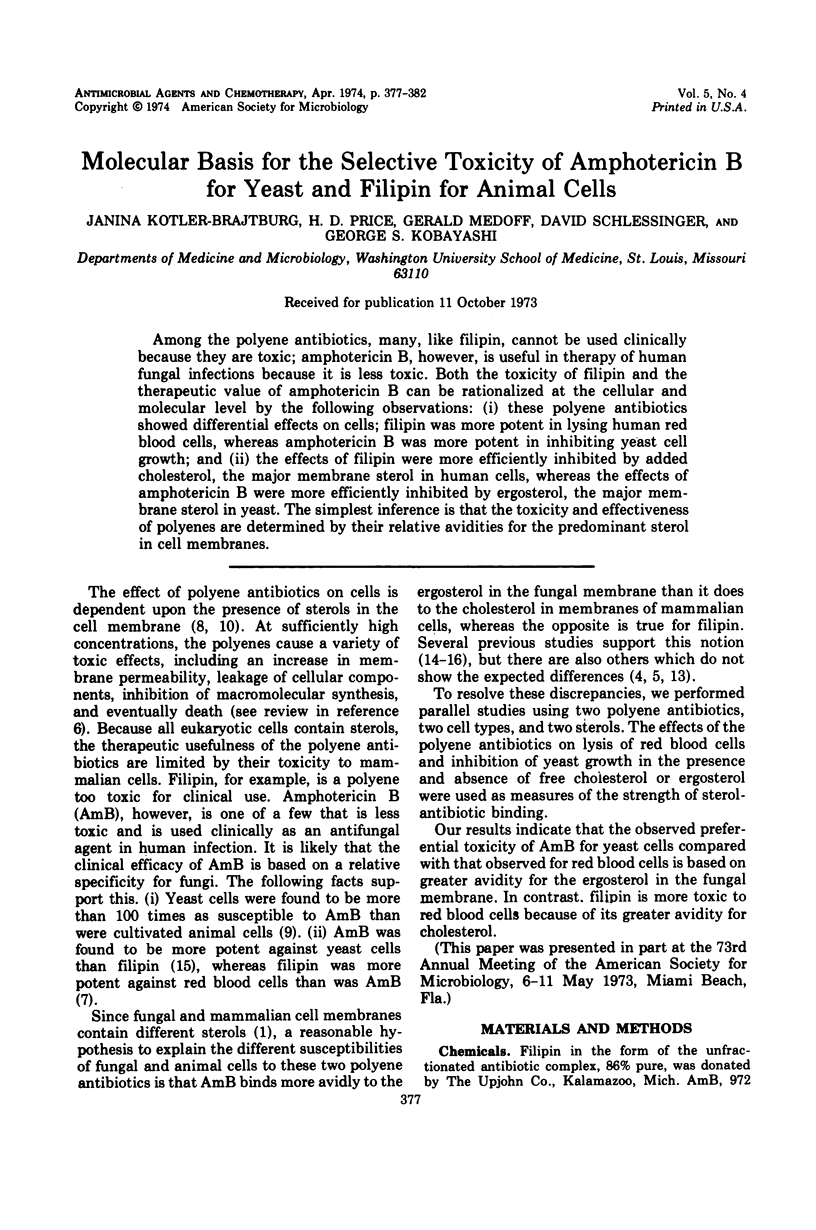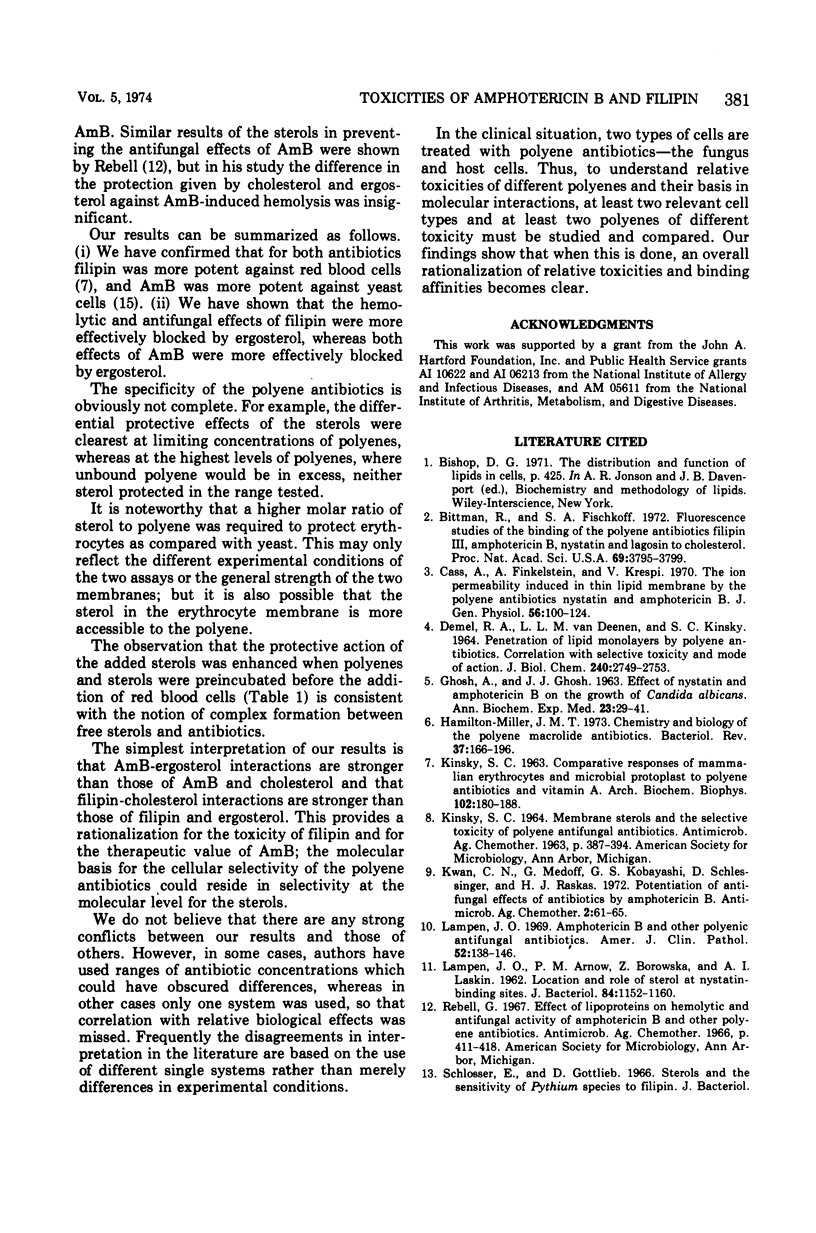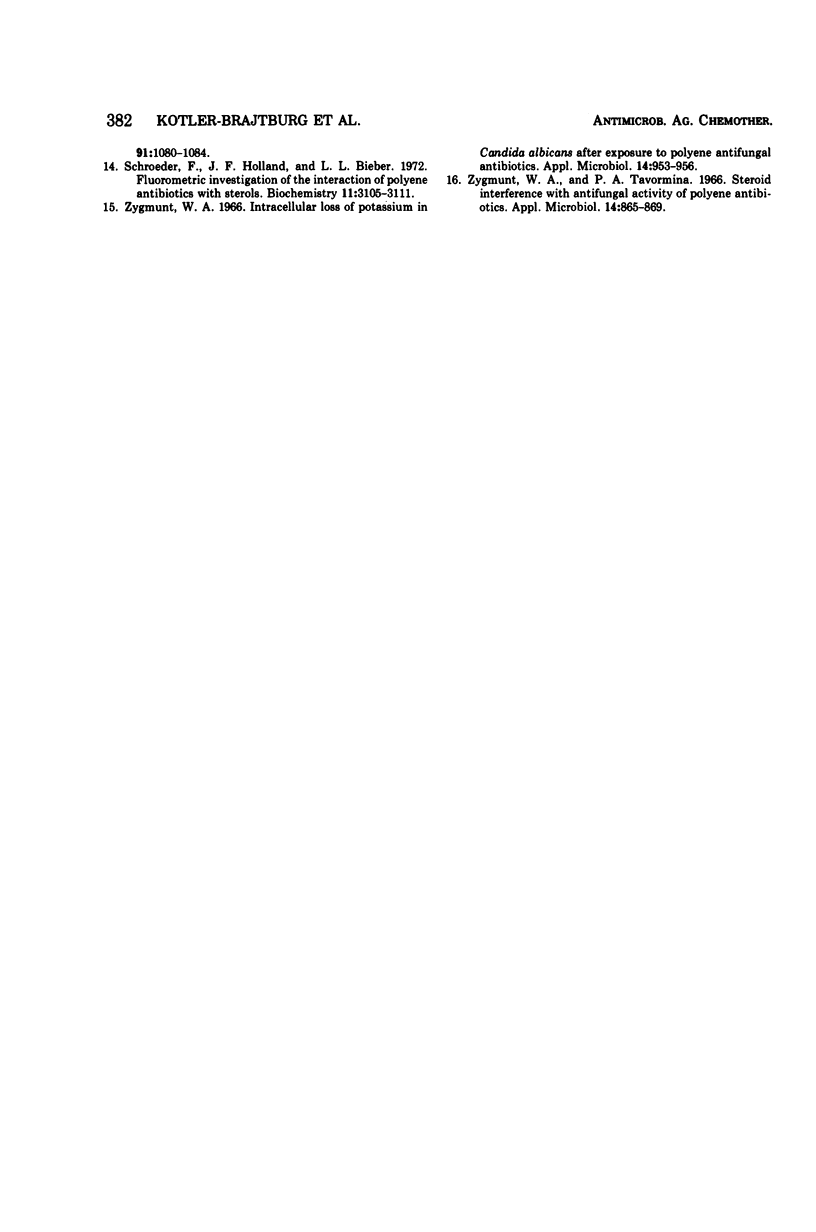Abstract
Among the polyene antibiotics, many, like filipin, cannot be used clinically because they are toxic; amphotericin B, however, is useful in therapy of human fungal infections because it is less toxic. Both the toxicity of filipin and the therapeutic value of amphotericin B can be rationalized at the cellular and molecular level by the following observations: (i) these polyene antibiotics showed differential effects on cells; filipin was more potent in lysing human red blood cells, whereas amphotericin B was more potent in inhibiting yeast cell growth; and (ii) the effects of filipin were more efficiently inhibited by added cholesterol, the major membrane sterol in human cells, whereas the effects of amphotericin B were more efficiently inhibited by ergosterol, the major membrane sterol in yeast. The simplest inference is that the toxicity and effectiveness of polyenes are determined by their relative avidities for the predominant sterol in cell membranes.
Full text
PDF





Selected References
These references are in PubMed. This may not be the complete list of references from this article.
- Bittman R., Fischkoff S. A. Fluorescence studies of the binding of the polyene antibiotics filipin 3, amphotericin B, nystatin, and lagosin to cholesterol. Proc Natl Acad Sci U S A. 1972 Dec;69(12):3795–3799. doi: 10.1073/pnas.69.12.3795. [DOI] [PMC free article] [PubMed] [Google Scholar]
- Cass A., Finkelstein A., Krespi V. The ion permeability induced in thin lipid membranes by the polyene antibiotics nystatin and amphotericin B. J Gen Physiol. 1970 Jul;56(1):100–124. doi: 10.1085/jgp.56.1.100. [DOI] [PMC free article] [PubMed] [Google Scholar]
- DEMEL R. A., VAN DEENENL PENETRATION OF LIPID MONOLAYERS BY POLYENE ANTIBIOTICS. CORRELATION WITH SELECTIVE TOXICITY AND MODE OF ACTION. J Biol Chem. 1965 Jun;240:2749–2753. [PubMed] [Google Scholar]
- GHOSH A., GHOSH J. J. EFFECT OF NYSTATIN AND AMPHOTERICIN B ON THE GROWTH OF CANDIDA ALBICANS. Ann Biochem Exp Med. 1963 Jan;23:29–44. [PubMed] [Google Scholar]
- Hamilton-Miller J. M. Chemistry and biology of the polyene macrolide antibiotics. Bacteriol Rev. 1973 Jun;37(2):166–196. [PMC free article] [PubMed] [Google Scholar]
- KINSKY S. C. COMPARATIVE RESPONSES OF MAMMALIAN ERYTHROCYTES AND MICROBIAL PROTOPLASTS TO POLYENE ANTIBIOTICS AND VITAMIN A. Arch Biochem Biophys. 1963 Aug;102:180–188. doi: 10.1016/0003-9861(63)90169-3. [DOI] [PubMed] [Google Scholar]
- KINSKY S. C. MEMBRANE STEROLS AND THE SELECTIVE TOXICITY OF POLYENE ANTIFUNGAL ANTIBIOTICS. Antimicrob Agents Chemother (Bethesda) 1963;161:387–394. [PubMed] [Google Scholar]
- Kwan C. N., Medoff G., Kobayashi G. S., Schlessinger D., Raskas H. J. Potentiation of the antifungal effects of antibiotics by amphotericin B. Antimicrob Agents Chemother. 1972 Aug;2(2):61–65. doi: 10.1128/aac.2.2.61. [DOI] [PMC free article] [PubMed] [Google Scholar]
- LAMPEN J. O., ARNOW P. M., BOROWSKA Z., LASKIN A. I. Location and role of sterol at nystatin-binding sites. J Bacteriol. 1962 Dec;84:1152–1160. doi: 10.1128/jb.84.6.1152-1160.1962. [DOI] [PMC free article] [PubMed] [Google Scholar]
- Lampen J. O. Amphotericin B and other polyenic antifungal antibiotics. Am J Clin Pathol. 1969 Aug;52(2):138–146. doi: 10.1093/ajcp/52.2.138. [DOI] [PubMed] [Google Scholar]
- Rebell G. Effect of lipoproteins on hemolytic and antifungal activity of amphotericin B and other polyene antibiotics. Antimicrob Agents Chemother (Bethesda) 1966;6:411–418. doi: 10.1128/AAC.6.4.411. [DOI] [PubMed] [Google Scholar]
- Schroeder F., Holland J. F., Bieber L. L. Fluorometric investigations of the interaction of polyene antibiotics with sterols. Biochemistry. 1972 Aug 1;11(16):3105–3111. doi: 10.1021/bi00766a026. [DOI] [PubMed] [Google Scholar]
- Zygmunt W. A. Intracellular Loss of Potassium in Candida albicans After Exposure to Polyene Antifungal Antibiotics. Appl Microbiol. 1966 Nov;14(6):953–956. doi: 10.1128/am.14.6.953-956.1966. [DOI] [PMC free article] [PubMed] [Google Scholar]
- Zygmunt W. A., Tavormina P. A. Steroid interference with antifungal activity of polyene antibiotics. Appl Microbiol. 1966 Nov;14(6):865–869. doi: 10.1128/am.14.6.865-869.1966. [DOI] [PMC free article] [PubMed] [Google Scholar]


